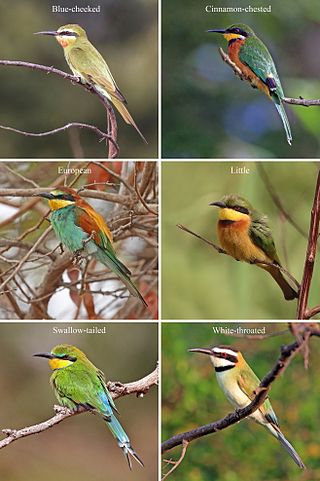
The bee-eaters are a group of birds in the family Meropidae, containing three genera and thirty species. Most species are found in Africa and Asia, with a few in southern Europe, Australia, and New Guinea. They are characterised by richly coloured plumage, slender bodies, and usually elongated central tail feathers. All have long down-turned bills and medium to long wings, which may be pointed or round. Male and female plumages are usually similar.

The little bee-eater is a bird species in the bee-eater family, Meropidae. They are found in Sub-Saharan Africa. They should not be confused with the little green bee-eater. Migration is limited to seasonal movements depending on rainfall patterns.

The Asian green bee-eater, also known as little green bee-eater, and green bee-eater in Sri Lanka, is a near passerine bird in the bee-eater family. It is resident but prone to seasonal movements and is found widely distributed across Asia from coastal southern Iran east through the Indian subcontinent to Vietnam. Populations in Africa and the Arabian Peninsula that were formerly assigned to this species are now considered distinct species: the African green bee-eater and the Arabian green bee-eater. They are mainly insect eaters and they are found in grassland, thin scrub and forest often quite far from water. Several regional plumage variations are known and several subspecies have been named.
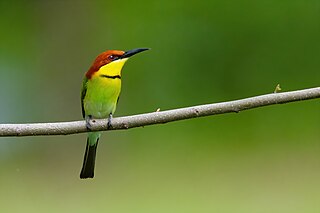
The chestnut-headed bee-eater, or bay-headed bee-eater, is a bird in the bee-eater family Meropidae. It breeds on the Indian subcontinent and adjoining regions, ranging from India east to Southeast Asia.

The sand partridge is a gamebird in the pheasant family Phasianidae of the order Galliformes, gallinaceous birds.

Blanford's fox is a small fox native to the Middle East and Central Asia. It is listed as Least Concern on the IUCN Red List.

The rainbow bee-eater is a near passerine bird in the bee-eater family Meropidae.

The Schokari sand racer is a species of psammophiid snake found in parts of Asia and Africa. Psammophis schokari aegyptius has been elevated to species status. Many people refer to snakes in the genus Psammophis as colubrids, but this is now known to be incorrect—they were once classified in the Colubridae, but our more sophisticated understanding of the relationships among the groups of snakes has led herpetologists to reclassify Psammophis and its relatives into Lamprophiidae, a family more closely related to Elapidae than to Colubridae.

The collared kingfisher is a medium-sized kingfisher belonging to the subfamily Halcyoninae, the tree kingfishers. It is also known as the white-collared kingfisher, black-masked kingfisher or mangrove kingfisher. It has a wide range extending from the Red Sea across southern Asia to Polynesia. A number of subspecies and subspecies groups have been split from this species including the Pacific kingfisher, the islet kingfisher, the Torresian kingfisher, the Mariana kingfisher, and the Melanesian kingfisher.
The Sind bat is a species of vesper bat and the only member of the genus Rhyneptesicus. It inhabits forests and arid areas near waterbodies in southwestern Saudi Arabia, Yemen and Oman, around the coast of the Gulf of Oman in southern Iraq and Iran. Isolated populations in southern Pakistan and northwestern Afghanistan occur up to an elevation of 862 m (2,828 ft). Its presence in Bahrain, Qatar and the United Arab Emirates is uncertain.

The Arabian toad is a species of toad in the family Bufonidae. It is endemic to the Arabian Peninsula and is found in Oman, Saudi Arabia, the United Arab Emirates, and Yemen.

The bar-tailed lark or bar-tailed desert lark is a species of lark in the family Alaudidae. Two other species, the rufous-tailed lark and the Cape clapper lark are both also sometimes referred to using the name bar-tailed lark. It is found from Morocco to Pakistan. Its natural habitat is hot deserts. This is in many places a common species, but elsewhere rather less common. It has a very wide distribution and faces no obvious threats, but surveys have shown that it is slowly decreasing in numbers. The International Union for Conservation of Nature has rated its conservation status as being of "least concern".
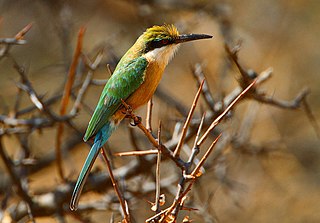
The Somali bee-eater is a species of bird in the family Meropidae. It is found in Ethiopia, Kenya, Saudi Arabia, Somalia and Tanzania. This is a small bee-eater that prefers arid country and desert areas where it may be locally common. The International Union for Conservation of Nature has assessed its conservation status as being of "least concern", postulating that clearing of woodland and forest is creating new suitable habitat for the bird and that its population trend may therefore be rising.
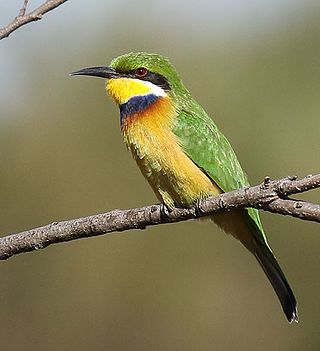
The blue-breasted bee-eater is a central African species of bird. It is a member of the family Meropidae. Meropids are all visually similar and have a diet specialized in Hymenopterans.

The blue-throated bee-eater is a species of bird in the bee-eater family. They are found throughout southeast Asia in subtropical or tropical mangrove forests. Their diet consists mostly of bees, wasps, and dragonflies. Blue-throated bee-eaters are small with colorful plumage consisting of a red nape, dark green wings, light green breast, and their signature blue throat. Juvenile plumage contain dark green head and wings and light green breasts, only developing their full plumage in adulthood. They have a rich variety of songs and calls, including longcalls which allow them to communicate long distances in the forest.

The wildlife of Saudi Arabia is substantial and varied. Saudi Arabia is a very large country forming the biggest part of the Arabian Peninsula. It has several geographic regions, each with a diversity of plants and animals adapted to their own particular habitats. The country has several extensive mountain ranges, deserts, highlands, steppes, hills, wadis, volcanic areas, lakes and over 1300 islands. The Saudi Arabian coastline has a combined length of 2,640 km (1,640 mi) and consists of the Gulf of Aqaba and the Red Sea to the west while a shorter eastern coastline can be found along the Persian Gulf.

The wildlife of Oman is the flora and fauna of this country in the southeastern corner of the Arabian Peninsula, with coasts on the Gulf of Oman and the Arabian Sea. The climate is hot and dry, apart from the southeastern coast, and the country offers a variety of habitats for wildlife including mountains, valleys, deserts, coastal plains and sea coasts.
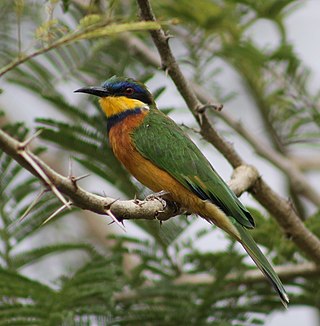
The Ethiopian bee-eater is a species of bird in the family Meropidae. It is found in Ethiopia and Sudan. It was formerly considered a subspecies of the blue-breasted bee-eater.
Green bee-eater has been split into the following species:

The African green bee-eater is a species of bird in the family Meropidae. It is found throughout arid regions of Africa from Senegal east to Ethiopia, and has expanded its range north to Egypt over the past few decades.




















